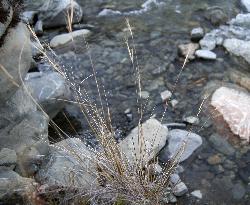- Taxon
- Gallery
- ≡ Triticum solandri Steud., Syn. Pl. Glumac. 347 (1854)
- ≡ Elymus solandri (Steud.) Connor, New Zealand J. Bot. 32: 140 (1994)
- = Triticum squarrosum Banks & Sol. ex Hook.f., London J. Bot. 3: 417 (1844) nom. illeg.
Open glaucous grass, prostrate to decumbent to ascending, erect, stoloniferous or tufted, intra- and extravaginally branching, rooting and shooting at nodes, leaf-blades flat to inrolled. Leaf-sheath to 5 cm, keeled, pubescent especially when young, hairy or glabrous, becoming fibrous. Ligule to 0.5 mm, truncate. Collar thickened, recurved, hairs (0.75 mm) dense or short and sparse; occasionally with long hairs on margin. Auricles 1–1.5 mm, clasping, hairs 1–1.5 mm. Leaf-blade 21 cm × 2–4 mm, glaucous, flat or folded or inrolling, abaxially ribbed, occasionally with some long retrorse hairs, adaxially short hairy or prickled on ribs, some long hairs forming a weft at base becoming short above; margin involute, glabrous or faintly toothed. Culm 40–100 cm, prostrate, erect or ascending, internodes glabrous. Inflorescence 8–20 cm, of 3–15 spikelets. Spikelets 25–80 mm, of 4–10 florets. Glumes unequal, keeled, margins membranous, sometimes produced to a point or becoming awned, prickle-toothed above, lower 3–11 mm, 3-nerved, upper 5–12 mm, 3–5-nerved. Lemma with central nerve prominent and extending into recurved awn 35–75 mm, smooth except for a few prickle-teeth on nerves below awn and along margins, sometimes toothed at apex. Palea 9.5–12 mm, apex pointed and bifid. Rachilla 1.5–3 mm, shortly stiff hairy. Callus 0.75 mm, hairs just reaching lemma. Lodicules 1.25–1.5 mm, ligulate. Anthers 3–5 mm. Gynoecium: ovary 1.5 mm; stigma-styles 2.5–3 mm. Caryopsis to 6.5 mm; embryo 1.5 mm. 2n= 42.
[From: Edgar and Connor (2000) Flora of New Zealand. Volume 5 as Elymus solandri (Steud.) Connor]




